HEILONGJIANG PROVINCE
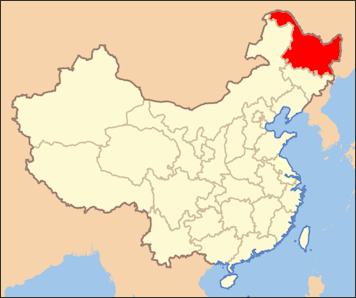
Heilongjiang Province HEILONGJIANG PROVINCE is China's northernmost province. Known as the "Land of the Black Dragon River", it is the last province in China with large stands of forest and people who raise reindeer. Black Dragon River is another name for the Amur River, which forms part of the province’s border with Russia. Northern Heilongjiang is the home of the Oroqen people, a group of reindeer-herding nomads and hunters related to tribes in Siberia.
Heilongjiang is the second poorest province in China. In the winter Heilongjiang is extremely cold and the temperature drops below zero almost everyday. The rivers begin freezing in October and snow coves the ground until May. People often don't bath and wear coats and hats at mealtime because hot water and heating oil are in short supply.
Heilongjiang is known as "the king of soybeans." Even though the growing season lasts only 120 days, this region still produces bountiful harvests of corn and soybean because of the long daylight hours and the rich black soil. Ginseng, sika deer and red deer are all raised on farms. northeast China.
The sixth largest province in China, Heilongjiang covers 454,800 square kilometers (175,600 square miles) and has a population density of 75 people per square kilometer. According to the 2020 Chinese census the population was around 32 million, about six million less than 2010. About 60 percent of the population lives in urban areas. Harbin is the capital and largest city, with about 5.2 million people. Han Chinese make up 93.5 percent of the population, followed by Manchu (4.6 percent), Koreans (1.27 percent); Hui (0.43 percent); Mongols (0.14 percent); Xibe (0.05 percent); Russians (0.01 percent); and Others 0.05 percent). Among the small ethnic groups that live there are Daur, Xibe, Ewenki, Oroqen and Hezhen. Maps of Heilongjiang: chinamaps.org
The population of Heilongjiang was 31,850,088 in 2020; 38,312,224 in 2010; 36,237,576 in 2000; 35,214,873 in 1990; 32,665,546 in 1982; 20,118,271 in 1964; 11,897,309 in 1954; 2,844,000 in 1947; 3,751,000 in 1936-37; 3,725,000 in 1928; 2,029,000 in 1912. [Source: Wikipedia, China Census]
The name Heilongjiang (pinyin: Hēilóngjiāng Shěng; Postal map spelling: Heilungkiang) is derived from the Heilongjiang River. "Heilongjiang" literally means Black Dragon River, which is the Chinese name for the Amur. The one-character abbreviation is “Hēi.” The Manchu name of the region is Sahaliyan ula (literally "Black River"), from which the name of Sakhalin (as in Sakhalin Island, Russia) is derived. The Mongolian name accordingly is Qaramörin.
Geography and Climate of Heilongjiang
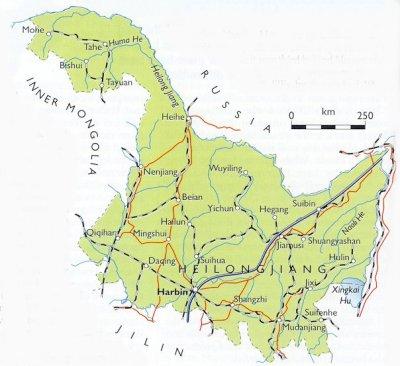
Heilongjiang mapHeilongjiang borders Jilin province in the south, Inner Mongolia to the west and Russia to the north and east. Heilongjiang’s name is derived from the Heilongjiang River (the Amur River), the tenth largest river in the world. The Amur River marks the border between China and Russia to the north. Heilongjiang contains China's northernmost point (in Mohe County along the Amur) and easternmost point (at the junction of the Amur and Ussuri Rivers).
The main geographical features of Heilongjiang are the Greater and Lesser Khingan mountain ranges and extensive Sanjiang Plain. There are also rolling hills, vast grasslands and agricultural fields, dense forests and volcanic landforms. Heilongjiang, Songhuajiang and Ussuri are large rivers that either flow through the province or form its borders.
Heilongjiang faces Russia on the opposite bank of the Heilongjiang River (Amur River) in the north and the Ussuri River in the east. The border between the province and Russia extends for 3,045 kilometers. Much of the province is dominated by relatively low mountain ranges: the Greater Khingan Range, Lesser Khingan Range, Zhangguangcai Mountains, Laoye Mountains, and Wanda Mountains. The highest peak is 1690-meter (5,545-foot) -high Mount Datudingzi at the border with Jilin province). The Greater Khingan Range contains China's largest remaining virgin forest and thus is an important area for China's timber industry.
The interior of Heilongjiang province, which is relatively flat, with a low elevation, contains the Muling River, the Naoli River, the Songhua River, the Nen River, and the Mudan River, all tributaries of the Amur. Xingkai Lake (or Khanka Lake) is found on the border with Russia's Primorsky Krai.
The climate for most of Heilongjiang is humid continental though areas in the far north have a subarctic climate. Winters are long and very cold, with average temperatures of −31 to −15 °C (-24 to 5 °F) in January. Summers are short and not so hot an average of 18 to 23 °C (64 to 73 °F) in July. The annual average rainfall is 400 to 700 millimeters (16 to 28 inches), with much of it falling as rain in summer. Snow falls in the winter but there isn’t so much of it. Clear weather is prevalent throughout the year. Spring, especially in the Songnen Plain and Sanpingjiang Plains, can be very windy.
Northeast China (Manchuria)
Northeast China is a cold and sparsely populated region that embraces Liaoning, Jilin and Heilongjiang provinces — which together cover an area of 308,000 square miles and have a population of 107 million people. Known to the Chinese simply as Dongbei (the Northeast), and to Westerners as Manchuria, it encompasses fertile plains, forested mountains and remnants of minorities that survived by hunting and herding reindeer. The term Manchuria is generally not used by Chinese because its association with the Japanese occupation.
Northeast China covers 1.554 million square kilometers (600,000 square miles), an area roughly the size of Alaska. It is separated from Siberia and Russia by the Amur River and two of its tributaries, the Argus and Ussuuri. The Tumen and Yalu Rivers divide it from North Korea. It south coast lies on the opening of the Yellow Sea. Inner Mongolia and Northeast China are roughly separated by the Khingan Mountains.
The northeast is diverse geographically, embracing the strategic natural harbor at Dalian, the heavily-populated Manchurian plain, rugged mountains along Korean border, and wetlands and forests in the north along the Russian border. In terms of agriculture, Jilin has traditionally been China's largest exporter of corn and tobacco, Heilongjiang is known as "the king of soybeans," and Liaoning's apples, peaches, and pears are exported throughout Asia. Ginseng from southern Jilin's Changbai mountain is a staple of Chinese traditional medicine.
The winters in Northeast China are cold and dry. The summers can be hot and wet. More than half the annual rain falls in July and August. During this time large amounts of corn, wheat, millet and soybeans are raised in the fertile, dark soil. There are also sizable fur and fishing industries. Fushun contains the world's largest open pit coal mine. Many of the cities are heavily industrialized.
The region is ethnically diverse. Although dominated by Han Chinese there are a strong Manchu, Mongolian, and Korean influences. The southern part of Jilin Province contains the Yanbian Korean Autonomous Prefecture, known as "China's Korean Corner" and is home to several million ethnic Korean Chinese. Today Han Chinese make up 95 percent of the region's population. There are also sizable numbers of Mongols and Koreans. Unusual minorities include the Oroqen nomads, the Dauers, Ewenki and Hezhen. Their numbers are very small.
Northeast Chinese dishes include frozen melons, bread, vanilla ice cream, stewed moose nose with mushroom, Mongolian hot pot, "yellow flower" (chopped lily stalks), white fungus soup, monkey-leg mushrooms, Harbin potato-eggplant salad, pheasant shashlik. Near Russia dishes made with fatty meat, potatoes, rice gruel, stuffed cabbage, and green peppers covered in gravy are available.
History of Heilongjiang
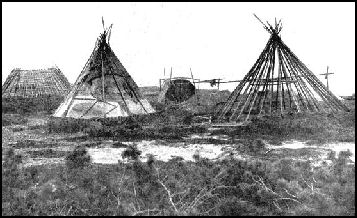
Oroquen birch bark tents In ancient times Heilongjiang was very remote and had little contact with outsiders. Information about it was limited. Ancient Chinese records and other sources state that Heilongjiang was inhabited by people such as the Buyeo, the Mohe, and the Khitan. Some names are Manchu or Mongolian. The eastern portion of Heilongjiang was ruled by the kingdom of Balhae between the 7th century and 10th century. The Jurchen Jin Dynasty (1115–1234) that subsequently ruled much of north China arose within the borders of modern Heilongjiang.
The Jurchen Jin (Zhurdzhen) Dynasty ruled parts of what is now China, Mongolia and Russia. In the 13th century, they were defeated by Genghis Khan and the Mongols and survived in scattered communities in the forest, where they became nomadic hunters to survive and formed their own language and culture, called Udegeh. There are only about Udegeh 2,000 left. The largest group lives in a village called Krasnyr, about 175 miles southeast of Khabarovsk, Russia. The Udegeh live in wooden houses that often have painted gables with images of bears, dogs, devils and pagan goddesses. Their villages are surrounded by forests, and in the winter deep snow. They primarily live on animals they hunt such as sable, mink, squirrel, deer and boar. They often earn what little money they have by collecting wild ginseng in the forest or selling furs.
Heilongjiang as an administrative entity was created in 1683, during the Kangxi era of the Manchu Qing Dynasty, from the northwestern part of the Jilin province. This Heilongjiang Province only included the western part of today's Heilongjiang Province, under the supervision of the General of Heilongjiang. The eastern part of what's today Heilongjiang remained under the supervision of the General of Jilin, whose power reached the Sea of Japan. These areas were initially closed off to Han Chinese migration.
The original seat of the Military Governor of Heilongjiang was in Heilongjang City (also known as Aigun or Heihe, or, in Manchu, Saghalien Ula) on the Amur River. But later it was moved southward, in 1690, to Nenjiang (Mergen) on the Nen River, and, in 1699, further south to Qiqihar, due to supply concerns, Nenjiang and Qiqihar are connected by the Nen River with southern Manchuria while reaching the Amur area required going out to sea and navigating up the Sungari River and Amur Rivers, which are frozeb much of the year. The only other option was portaging over the Lesser Xing'an Mountains between the Nen River valley and the Amur valley. Another advantage of Qiqihar was its location at the junction of a northbound road (to Nenjiang) and a westbound one (to Mongolia), enabling its garrison to serve for the defense both against the Russians and the Ölöt Mongols.
In 1858 and 1860 the Qing government were forced to give up all land beyond the Amur and Ussuri Rivers — a region known as Outer Manchuria — to the Russian Empire, cutting off Manchu Qing Empire from the Sea of Japan and giving Heilongjiang its present northern borders. At the same time, Manchuria was opened to Han Chinese migration by the Qing government. By the early twentieth century, due to the Chuang Guandong, the Han Chinese had become the dominant ethnic group in the region.
In 1932, present-day Heilongjiang became part of the Japanese puppet state of Manchukuo. In 1945 Japanese were defeated by Soviet Army.During Chinese Civil War Heilongjiang became the first province to be completely controlled by the Chinese communists and Harbin the first major city to be controlled by them. At the beginning of communist rule, Heilongjiang province included only the western portion of the present-day province, and had its capital at Qiqihar. The remaining area was the province of Songjiang; its capital was Harbin. In 1954, these two provinces were merged into present-day Heilongjiang. During the Cultural Revolution, Heilongjiang was also expanded to include Hulunbuir League and some other areas previously in Inner Mongolia; this has since mostly been reversed.
Early History of Northeast China
Northeast China is the traditional homeland of the Manchu — hence the name Manchuria. Originally a Mongol-like nomadic people, the Manchus ran China during the Qing dynasty from 1644-1912. For much of its history, Northeast China was a frontier land. It wasn’t really settled until the late 1800s and soon after that became the center of a strategic battle involving Russia, Japan, Korea, and China.
During different periods of time kingdoms and state-like entities rules by Koreans and Chinese nomadic groups ruled parts of northeast China. In the last half of the seventeenth century the imperial Qing government recruited migrants from south of the Great Wall (notably, from Shandong) to settle the relatively sparsely populated area of Fengtian Province (roughly corresponding to today's Liaoning). Many of the current residents of Liaoning trace their ancestry to these seventeenth century settlers. The rest of China's Northeast, however, remained officially off-limits to Han Chinese for most of the Manchu era. To prevent the migration of Chinese to those regions (today's Jilin and Heilongjiang, as well as the adjacent parts of Inner Mongolia), the so-called Willow Palisade was cons 1638 and 1672.
During the Qing Dynasty, Manchuria was ruled by three generals, one of whom, the General of Shengjing, ruled much of modern Liaoning. In 1860, the Manchu government began to reopen the region to migration, which quickly resulted in Han Chinese becoming the dominant ethnic group in the region.
Later History of Northeast China
Northeast China has been described as China's “cradle of industrialization." It was first developed by Japanese and Russian colonists. Between 1931 and 1945, it was occupied by the Japanese, who harvested its abundant resources — timber, coal, iron, copper, molybdenum, manganese and aluminum — and built factories that supplied by Japanese military machine. After the World War II the region was briefly occupied by the Russians and was the site of decisive victories by the Communists and over the Kuomintang.
Under Mao it was turned into the industrial heartland of China. Coal-fired power plants, iron-and-steel mills, oil wells and factories were built that churned out the majority of China's steel, cars, ships, and oil — 1 6 percent of China's industrial output with juts 8 percent of the population — and created lots of jobs but also produced a lot waste and pollution.
The northeast was home to some of China's largest state enterprises, including the massive Anshan Steel Works, the First Auto Works, and the Jilin Petrochemical Corporation But in a very short time Northeast China has gone from China's economic powerhouse to a region left behind to a region on the rebound. It suffered under the Deng reforms. Many of the state-run factories had become obsolete and were shut down, resulting in huge lay offs. Of the 31 mullion Chinese who lost their jobs between 1998 and 2002, one quarter lived in the Northeast.
In 2003, the “Revitalize the Northeast" Campaign was launched, offering job training and language classes for unemployed and luring foreign companies with high tech centers, tax breaks and other incentives. The region attracted a lot of foreign investment particularly from Japan and South Korea but considerable less than the Shanghai area and southern China.
Northeast China still has a ways to go to turn itself around. It still suffers from one of the highest unemployment rates in China. Many of those that are employed work for inefficient state-run enterprises that should be shut down. Many of those who are unemployed don't have skills employers want.

Daqing poster
Places in Heilongjiang
Daqing (about 200 kilometers northwest of Harbin) has traditionally been the center of China's oil industry. Hundreds of old pumps are scattered around the region bobbing up and down, pumping out the last drops of oil as the wells dry up.. Zhalong Nature Reserve (around 300 kilometers northwest of Harbin) contains one of the world's largest populations of rare white-naped cranes.
Jingbo Lake (97 kilometers south of Mudanjiang) is the largest lava-blocked lake in China. The lake is hidden amidst precipitous cliffs, forested peaks and lush foliage. Mountains on the lakesides are reflected on the placid water. Countless islets, big and small, are scattered on the lake. Among its eight famous isghts are the Tiaoshuilou (Diaoshuilou) Waterfall, Pearl Gate, Great Gushan Mountain and Little Gushan Mountain. The Tiaoshuilou Waterfall drops with great momentum from the mountaintop. In rainy or flood season, the waterfall may be widened into more than 200 meters. Lake Jingbo, in Ning'an County, is a section of the Mudan River that has been narrowed and shaped by volcanic eruptions.
Amur River
Black Dragon River (on the Russian border), or Heoling Jang, is the Chinese name of river that Russians and most maps identify as the Amur. The Amur River is the third longest river in Chinese territory, the third longest river in Russia, the 10th longest in the world and the most important waterway in the Russian Far East. Originating in the high plateaus of Mongolia and Siberia, it is 2,824 kilometers (1756 miles) long (starting from the confluence of the Shilka and the Argun) or the 4,166 kilometers (2,744 miles) long is you include the Argun River, the longer if its two feeder rivers. The Amur River flows along and defines and fairly large part of the Russian-Chinese border. It empties into the Sea of Okhotsk, a branch of the Pacific Ocean, where its mouth is over 16 kilometers (ten miles) wide. The Amur’s drainage basin, which includes parts of Mongolia, Siberia and China, is approximately 1,844,000 square kilometers (712,000 square miles), an area six times the size of Italy. [Source: Simon Winchester, National Geographic, February 2000]
The Amur River forms many oxbow lakes, channels, and backwater areas. Taiga, birch forests and wetlands flank long stretches of the river. One hundred species of fish live in its waters, including massive kaluga sturgeon, which can reach over six and half meters (20 feet) in length, weigh more than a ton, live to be 100 and produce 400 pound of valuable caviar. Salmon are the most important fish. Each year the salmon run lasts for almost three months. The waters also carry 25 million tons of silt to the North Pacific every year. Although the Amur is primarily a slow, lazy river it is not utilized commercially since it is so remotely located.
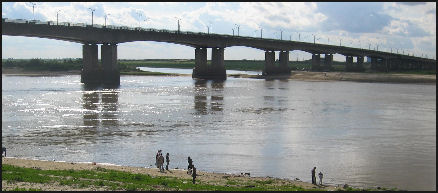
Songua River, a tributary of the Amur
The tributaries of the Amur are fed mostly by monsoon rains. Consequently its water levels rise dramatically during the summers and drop during the dry winter. From May to November, when the river is free of ice, the Amur is navigable it entire length. During the winter, the Amur freezes over for as long as six months. The ice is up to two meters (six feet) deep. Vehicles are driven on the river and floating docks are pulled up from the shores. The remainder of the year it is used by variety of boats, including barges, ferries and gunboats, which are the primary means of transportation.
The Amur Basin in located within three countries: Russia, China, and Mongolia. In Mongolia it is called the Khara-Muren which means “Black River”; in China it is called Heilong Jiang (Hēilóng Jiāng) — “Black Dragon”. The Russian part of the basin consists of two unequal parts: 1) Siberian, with the respective parts of the Shilka and Argun river basins; and 2) the Far-East, where the major part of the Amur valley is located. It includes the left bank of the upper and middle Amur and the whole lower Amur with tributary basins.
According to Russian navigational directions, the Amur is divided into three parts: 1) the Upper Amur: before the city of Blagoveschensk; 2) the Middle Amur: from Blagoveschensk to Khabarovsk; 3) the Lower Amur: after Khabarovsk. There are only three bridges across the Amur. No dams have been built. In recent years fishermen have been complaining about pollution which comes from both Chinese and Russian sources.
Route of the Amur River
The Amur River flows in Russia and along the Russian-Chinese border. It is 2,824 kilometers long — starting from the confluence of the Shilka and the Argun — and flows into the Sea of Okhotsk. The Shilka is a river in Zabaykalsky Krai, southeastern Russia. It is 560 kilometers (350 miles long and originates at a confluence of the Onon and Ingoda rivers. The river is navigable for its entire length.
The Argun or Ergune is a 1,621 kilometers (1,007 miles) and forms part of the eastern China–Russia border, together with the Amur River. Its upper reaches are known as Hailar River The Argun marks the border (established by the Treaty of Nerchinsk in 1689) between Russia and China for about 944 kilometers (587 miles), until it meets the Amur River. The section of the Amur that defines the border between northern China and southeast Russia is 1,770 kilometers (1,100 miles) long. The region was the site of a battle between the Manchu-Chinese and Cossack-Russians in 1689. The current borders are the result of the Treaty if Aigun, signed in 1858, which the Chinese regarded as only temporary.
The Amur formally begins near the forest town of Skovorodino, where the Argun and Shilka Rivers join to form the Amur proper. The eastern end of the Bezumny (Mad) Island is considered its source. Other major tributaries include the Zeya, the Bureya and the Amgun rivers to the north and the Sunagri and Ussuri to the south.
The final 1045 kilometers (650 miles) of the river flows completely through Russia. From Khabarovsk, the Amur heads north for 650 kilometers (400 miles), passing through remote forests, swamps, muddy coastal flatlands and empties into the Sea of Okhotsk, an arm of the Pacific Ocean, by way of a large gulf by of the drab city of Nokolayevsk. Boat captains hate navigating the final section because the water is shallow and the navigable channels change all the time.
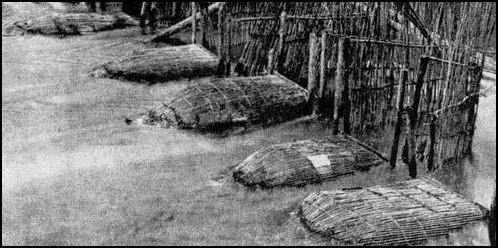
Fish traps
Amur River Fish
More than 100 species of fish live in the Amur’s waters, including massive kaluga sturgeon, which can reach over six and half meters (20 feet) in length, weigh more than a ton, live to be 100 and produce 400 pound of valuable caviar. Salmon are the most important commercial fish. Each year the salmon run lasts for almost three months.
The inhabitants of the Amur include valuable species of fish that swim upstream during the spawning period — the Siberian salmon and the hunchback salmon. Less valuable species include crucians, European carp, silver carp, predatory carp, Amur catfish, Amur pike, and grass carp.
The Amur is among richest rivers in terms of fish species. Aby one count there are at least 123 species of fish from 23 families inhabiting the Amul. The majority are of the Gobioninae subfamily of Cypriniformes, followed in number by Salmonidae. Several of the species are endemic. Pseudaspius and Mesocottus are monotypic genera found only in the Amur and some nearby coastal rivers. Few other rivers in the world have more than 100 species of fish,.
Four species of the Acipenseridae family can be found: the kaluga, Amur sturgeon, Sakhalin sturgeon and sterlet. The Kaluga and Amur sturgeon are endemic. The sterlet was introduced from the Ob river in the 1950s. Large predatory fish include the as northern snakehead, Amur pike, taimen, Amur catfish, predatory carp and yellowcheek,[4] as well as the northernmost populations of the Amur softshell turtle[5] and Indian lotus.
People on the Amur River
About 8½ million people live on the Amur’s length. Those that live on the Chinese side are noticeable more prosperous than those on the Russian side. Ferries are the primarily means of transportation across the river in the summer. Buses cross the ice in the winter.
Not as many people cross the river as you would think because Russians and Chinese remain so suspicious of one another. Those that cross are primarily Russian and Chinese traders carrying Russian-bound plastic bags filled with blocks of tea, T-shirts, sandals, whiskey and even Chinese-made vodka.
The Nania, Ulchi and Evenki are th main ethnic groups that have traditionally lived along the Amur river. Some villages still have shaman and do the old dances but many of the traditions are being lost and young people are more interested in the modern world than the old world. There are about 30,000 Evenks in Evenk, National Area, Yakutia, Taimyr, Buryatia and Sakhalin.
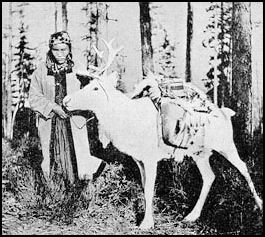
Oroquen tribal people
The Ulchi people live along the Amur River in Krabarovsk Territory. There are about 2,500 of them. They have traded in their traditional fishing boats for boats with outboard motor. The Ulchi, Nanai and Evenki wore fish skin clothes or clothes with fish skin parts. Some Amur River people wore coats of embroidered salmon skin. See Separate Article HEZHEN: THE FISHSKIN CLOTHES PEOPLE factsanddetails.com
The Nanai live in the Khabarovsk Territory and Promotye Territory of the lower Amur basin in the Russian Far East. Formally known to Russians as the Goldi people, they are related to the Evenki in Russia and the Hezhen in China and have traditionally shared the Amur region with the Ulchi and Evenki. They speak an Altaic language related to Turkish and Mongolian. Nanai means “local, indigenous person."
The Nanai have inhabited the Amur region since Neolithic times. On the banks of the Amur River archeologist have discovered 6,000 year old depictions of tigers carved the Goldi people. Their culture has been influenced by the ancient Tungus, Turkish and Mongolian tribes. They shared their territory with the Chinese Manchus and were not incorporated into Russia until the 1850s. After that many became Orthodox Christians and adopted Russian fishing methods and houses. Under, the Soviets, some were settled on fishing collectives. Others migrated to the cities and became involved in modern life.
The Nivkhs are an ethnic groups that live along the lower Amur River and on Sakhalin Island. Also known as the Gilak, Gilyak, Giriya and Nibuhi, they are the earliest inhabitants of Sakhalin Island and were described by Anton Chekhov in his book The Island. The speak a language related to the languages of the Ket, Yukagir, Chukchi and Koryak and have traditionally been seal hunters and fishermen who lived wooden or subterranean houses or spent time in temporary shelters made from fish skin while pursuing game and fish,
There are about 5,000 Nivkhs. About half live on the lower Amur River . The other half live on Sakhalin Island. They have traditionally hunted sea lions and seals with harpoons and clubs in the spring and fished much of the year, with a particular emphasis on catching Siberian and humpback salmon. The did some hunting and trapping and gathering of plants and kept dogs but were not involved in reindeer herding.
See Separate Article PEOPLE OF THE RUSSIAN FAR EAST factsanddetails.com
Amur River Bridges and Boats
There are only three bridges across the Amur. No dams have been built.The first permanent bridge across the Amur, the 2,590-meter (8,500-foot) -long Khabarovsk Bridge was completed in 1916, allowing the trains on the Transsiberian Railway to cross the river year-round without using ferries or rail tracks on top of the river ice. In 1941 a railway tunnel was added as well. Later, a combined road and rail bridge over the Amur at Komsomolsk-on-Amur (1975, 1400 meters long) and the road and rail Khabarovsk Bridge (1999; 3890 meters long) were constructed. These bridges are all in Russia.
The Tongjiang-Nizhneleninskoye railway bridge, first proposed in 2007, will connect Tongjiang in China with Nizhneleninskoye, a village in the Jewish Autonomous Oblast of Russia. The Chinese portion of the bridge was finished in July 2016. In December 2016, work began on the Russian portion of the bridge. The bridge is expected to open in 2020.
A 19-9-kilometer road-bridge is being built between Blagoveshchensk in Russia and Heihe in China. The project will include a 1.28-kilometer railroad bridge over the Amur River. The international highway will connect Jilin-Heilongjiang expressway in China to a highway in Blagoveshchensk, Russia. A 6.5-kilometer section of the highway is being built in China, starting in Changfatun, Heihe city. The remaining 13.4-kilometer is being constructed in Russia from Canikulgan village, Blagoveshchensk. The total cost of the project is US$358 million, of which China is paying US$81.7 million. The river bridge will be a low-pylon cable-stayed bridge (called the Amur Bridge in Russia). Construction started in 2016. [Source: .roadtraffic-technology]
Heihe, China
Heihe (across the Amur River from Blagoveshchensk, Russia) is a city in north Heilongjiang Province that has come alive since Russians have been allowed to enter China without a visa. The main shopping area is filled with Russian customers. Dumpling restaurants have had to open new branches to accommodate all the customers. Economic growth in Russia in recent years has given Russians money to spend and they like China as the prices there are half those in Russia.
In the 1990s the Heihe government set up a special trade zone on Daheihe Island, about a square kilometer in size, on the Amur River and allowed travel there without a visa. In 2004 the government expanded the trade zone to a 15-square-kilometer area that includes most of Heihe. About a half million Russians visit the city every year. They travel across the Amur by ship in the summer and by bus or hovercraft in the winter.
Many people have become prosperous selling goods. Heihe boast a five-star hotel topped by a revolving restaurant. The embankment has a promenade paved with white stone. There are plans to establish similar trade zones in other border town and encourage trade with Russia. However the Russian government doesn't want too many Chinese good to flow in and has restricted the amount of goods that can come in duty free and is reluctant to simplify customs procedures.
Heihe City is an important border city between China and Russia. It is separated from Inner Mongolia Autonomous Region by the Nen River on the west and from Amur Oblast in Russia by the Heilong River to the northeast. With long, chilly winters and cool, short summers, Heihe is a wonderful place to escape the heat of other Chinese cities. The most attractive scenic spots around the city include Wudalianchi Global Geopark, Ethnic Park, Laohei Mountain, Erlong Spring and Aihui Ancient Town. photo gallery; Admission: Wudalianchi Global Geopark: 150 yuan; Ethnic Park: 40 yuan; Laohei Mountain: 80 yuan; Erlong Spring: free; Aihui Ancient Town: free Getting There: Take a plane or train from Harbin to Heihe. Web Sites: Travel China Guide Travel China Guide Getting There: Heihe is accessible by bus and boat.
Blagoveshchensk
Blagoveshchensk (across the Amur River from Heihe) is a Russian border town on the Amur River with 214,000 people. The capital and largest city in Amur Oblast, it has wide streets, early 20th century brick building, a tsarist-era garrison and log cabins. It is one of the oldest settlements in the Russian Far East, founded in 1856. Many people make their living selling and distributing cheap Chinese consumer goods. Across the river, a distance of about 500 meters, is the booming Chinese town of Heihe. From June to September a ferry plies the river between Blagoveshchensk and Heihe. From November or March people make the crossing on ice road over the frozen Amur River. A new bridge is expected to
Blagoveshchensk is one of the oldest merchant cities of the Far East, and today acts as a link between Siberia, the Russian Far East and China. Places worth checking out include the Amur embankment and the arc de Triomphe. From Blagoveshchensk you can explore the taiga and Northern regions.
Most of the restaurants serve Chinese food and most of the fruit and vegetables are from China. Increasingly Chinese are building houses and farming the surrounding land. Many of city's Russian residents are hired by the Chinese to move goods into Russia. They are called "bricks," a reference to the brick-shaped duffle bags they use to carry goods. There are also many Russian women who work at brothels that cater to Chinese clients.
Ian Frazier wrote in The New Yorker: “Blagoveshchenie means “annunciation,” and the name is not too lofty for the city, which I thought the handsomest we’d been through since St. Petersburg. Blagoveshchensk is fortunate for two reasons—its light, and China. Something about the Pacific Ocean, maybe, gives a reddish-gold tint to light that spreads up the river and this far inland. The benign and hopeful sunniness of Blagoveshchensk reminded me somehow of Palo Alto, California. Blagoveshchensk and other Amur River cities could be the Golden East, as California was the Golden West. Or maybe this notion was just my homesick imagination. Still, the sun and blue sky and reddish-gold light as we drove around Blagoveshchensk struck me as imported, not quite Russian.” [Source: Ian Frazier, The New Yorker, August 10 and 17, 2009, Frazier is author of “Travels in Siberia” (2010)]
“Second, China: The Chinese industrial city of Heihe is just across the Amur. Our radio had begun picking up Chinese radio stations. On the other side of the pale-brown, slow-moving, dauntingly wide Amur the tops of the tallest buildings of Heihe could be seen. Like other Amur River cities, Heihe and Blagoveshchensk participate in an agreement that locally suspends certain visa and customs regulations for the purposes of encouraging trade. I saw several big buildings under construction in Blagoveshchensk, a rarity in these remote areas, and Chinese laborers working on them. The hard hats the workmen wore were made of wicker. A lot of the smaller structures in the city were new. Some had pagoda-style roofs. No thickets of morkovnik or other weeds grew along the streets, and the usually omnipresent trash, in heaps or promiscuously strewn, seemed to be gone.”
Oroqen
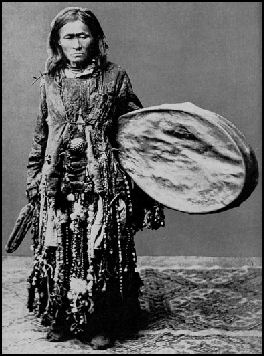
Oroquen shaman The Oroqen are one of the smaller minorities in China. Also known as the Orochen, Orochon, Elunchun, they are scattered over a large area of Heilongjiang and Inner Mongolia in northeast China. Up until the last couple of decades many Oroqen were hunters and forest nomads, similar to tribes found in Siberia. Most are settled now. Oroqen can mean both “mountain people” and “reindeer herder."
The Oroqen language belongs to the Manchu-Tungus group of the Altai family of languages. It is similar to Mongolian and the languages spoken by people native to Siberia. Most Oroqen have a good command of Chinese. Some also speak the Ewenki, Mongolian and Daur and other languages of the people that live near them. The Oroqen lived north of the Amur River in Siberia until they migrated into China to escape czarist Russian plunderers and then lived in the pine and birch forests the Greater and Lesser Xingan Mountains in Heilongjiang Province and eastern Inner Mongolia. The Chinese divided them into two groups: the Horse-Riding Oroqen and the Foot Oroqen.
The Oroqen live mainly in: 1) the northeast of Inner Mongolian Autonomous Region in Oroqen Autonomous Banner, Zhalantun, Molidawa Banner and Arong Banner; and 2) in the Heilongjiang province in Tahe county, Huma county, Xunke county, Jiayin county and Heihe city. Oroqen Autonomous County is situated in the east side of the Daxing'an Mountains and has a total area of 54,657 square kilometers and a population of 297,400. Of them only 2,100 are Oroqen. Most are Han Chinese and Mongolians. The Oroqen are mainly distributed in Nuoming, Wulubutie, Guli Townshiop and Tuozaming Village. [Source: Liu Jun, Museum of Nationalities, Central University for Nationalities, Science of China, China virtual museums, Computer Network Information Center of Chinese Academy of Sciences, kepu.net.cn ~]
See Separate Article OROQEN factsanddetails.com OLD OROQEN WAY OF LIFE factsanddetails.com
Ewenki
The Ewenki are a small ethnic minority that live in northern Heilongjiang Province and eastern Inner Mongolia. Closely related to the Tungus, Evenski and Yakut in Siberia and more distantly related to Kazakhs and Kyrgyz, they are a Turkic people who originated from the Lake Baikal region of Russia. They speak Tungus-Manchu languages, look like Mongolians and have traditionally herded reindeer, traded furs and hunted and fished. Many Ewenki migrated to northern China from the Lena River Valley in Siberia beginning in the mid 17th century. Reindeer were used mainly to haul tepees and bedrolls on long expeditions to hunt for moose, bear and wild boar. [Source: Encyclopedia of World Cultures: Russia and Eurasia/ China, edited by Paul Friedrich and Norma Diamond (C.K. Hall & Company, 1994)]
'Ewenki' is the name used by the Ewenki to describe themselves. It means “folks living in mountain forests” or "people living in the big mountain". Ewenki people used to live in the forest north of Lake Baikal and later moved east to the middle reaches of Heilongjiang River. In the past, the Ewenki were known as the 'Suolun', 'Tonggusi' and 'Yakute'—the names of different Ewenki groups that lived separately from one another. The joint name 'Ewenki' did not emerge as a widely used name until 1957.
The Ewenki language belongs to the Tungus-Manchu branch of Altaic linguistic family. There are three dialects — River Hui and Yimin (Buteha), River Moerge (Chenbaerhu) and Aoluguya (Erguna). Mongolian is the language generally used in pasturing areas, and Chinese is the language generally used in agricultural and mountainous areas.
See Separate Articles: EWENKI AND THEIR HISTORY factsanddetails.com ; EWENKI LIFE AND CULTURE factsanddetails.com
Hezhen
The Hezhen are one of China's smallest minorities. The 2010 census counted 5,300 of them, up from 1,500 in 1982. They live mostly in the Three-River Plain area in northern Heilongjiang, where the Songhia, Heilongjiang and Ussuri rivers come together. There used to be many more of them but 80 to 90 percent of them died under the Japanese occupation of Manchuria when they were resettled and forced to work in mines and railroads. The Chinese called them the “Fish Skin Tribe” because their traditional clothes, hats and shoes were made of fish skin.
Concentrated around the middle course of the Heilongjiang (Amur) River and the along the Songhua and Wusuli (Ussuri) Rivers, the Hezhen mainly live in Tongjiang city, Xilinzi village, Huachuan, Fujin, Fuyuan and Raohe counties in northeast China's Heilongjiang Province. Their most compact communities are in the villages of Jiejinkou, Sipai, and Bacha, three Hezhe Autonomous Townships. The Hezhen call themselves different names according to the region they inhabit: namely the Nanai, Nabei and Naniao. These three names mean "people of this place" in their respective dialects. The term Hezhe is the way people living down the Heilongjiang River called them. In Siberian Russia they are known as the Nanai. ~ *\
The area where the Hezhen live is a beautiful area with green hills and the clear waters in crisscrossing rivers in the summer and equally lovely in the winter when the landscape and rivers are covered by ice and snow. At present, there are the Hezhen-styled garden and tourist villages in Jiejinkou Township of Tongjiang, and Sipai Township of Raohe County. There, visitors can see performances of folk songs and dances, sample the delicious food of fishing families, and experience the traditional Hezhen way of life. [Source: Liu Jun, Museum of Nationalities, Central University for Nationalities, Science of China]
There is two million mu of grassland, 1.59 million mu of woodland (mostly secondary forests), 1.33 million mu of water area and 73 species of fishes in the city of Tongjiang itself. The city of Tongjiang was set as a treaty port more than a century ago. In 1994, it was designated by the Foreign Ministry to be an international port. It is easily accessible to tourists from Russian cities like Khabarovsk and Komsomolsk. Tourists from Japan and South Korea can also reach it.
See Separate Articles HEZHEN: THEIR HISTORY, FISH, RELIGION AND DYING LANGUAGE factsanddetails.com ; HEZHEN LIFE, CULTURE, STORIES AND FISHSKIN CLOTHES factsanddetails.com
Ussuri River
The Ussuri River forms the border between Russia and China in southern Khabarovsk. A right tributary of the Amur, it is 897 kilometers long, with a basin area of more than 193,000 square kilometers. The Ussuri River originates in the spurs of the central Sikhote-Alin. Once it descends into it the valley, the river becomes flat and gentle but has a steep rocky coast. In many area there are meandering channels.
Among the tributaries of the Ussuri are: 1) the upper river: Izvilinka, Sokolovka, Matveyevka and Pavlivka. 2) the left tributaries: Arsen'evka, Muling, Naoli River and Songacha River; 3) and the right tributaries: Pavlovka, Zhuravlovka, Big Ussurka, Bikin and Khor.
In Khabarovsk Krai, near the village of Kazakevichevo, Ussuri River flows into the shallow Kazakevichevo channel and after that the confluence of the Ussuri is called the Amur channel. The Amur channel empties into the Amur River in the center of the city of Khabarovsk. The Ussuri is a full-flowing river from May to August. In the summer and when the ice breaks there are frequent floods. Ice on the Ussuri breaks up in April and forms in November. The water is used for water supply. Above Lesozavodsk the river is navigable. Previously it was widely used for timber floating.
The Ussuri River is good for fishing and rich in fish. Gudgeon, crucian carp, common carp, trout, burbot, pike, catfish, flax and grayling are all caught as are Kaluga sturgeon, which can reach a huge size (eight meters recorded in the Amur River). The river is a spawning ground for salmon and chum salmon. In the waters of the Ussuri fish mountain rivers are found near the bottom fish. Mountain fish comes to the Ussuri in the spring to spawn.
Ussuri Taiga and Dersu Uzala
The Ussuri taiga is a forest different from the normal Russian taiga. Located between the Ussuri and Amur Rivers in the Far East and dominated by the Sikhot Alim Mountains, it is a monsoon forest filled with plants and animals found nowhere else in Siberia or Russia and instead are similar to those found in China, Korea and even the Himalayas. In the forest there is s lush undergrowth, with lianas and ferns. Wildlife include Siberian tigers, Asian black bears, Amur leopards and even tree frogs. The Siberian Tiger Project is located here. The 1970 Akira Kurosawa Oscar-winning film “Dersu Uzala,” and the book it was based on, about a Tungus trapper, was set here.
Ian Frazier wrote in The New Yorker: ““Dersu Uzala,” the memoir and narrative of exploration by Vladimir K. Arsenyev, begins in 1902, when Arsenyev is a young Army officer assigned the job of exploring and mapping the almost unknown regions east and northeast of Vladivostok, including Lake Khanka and the upper watershed of the Ussuri River. The name for the whole area is the Primorskii Krai—the By-the-Sea Region. It and much of the Khabarovskii Krai, just to the north of it, consist of a unique kind of Pacific forest in which tall hardwoods hung with vines grow beside conifers almost equally high, and the lushness of the foliage, especially along the watercourses, often becomes quite jungly. [Source: Ian Frazier, The New Yorker, August 10 and 17, 2009, Frazier is author of “Travels in Siberia” (2010)]
“In Arsenyev’s time, this jungle-taiga was full of wildlife, with species ranging from the flying squirrel and the wild boar to the Siberian tiger. Back then (and even recently) tigers could also be seen on the outskirts of Vladivostok, where they sometimes made forays to kill and carry off dogs. Arsenyev describes how tigers in the forest sometimes bellowed like red deer to attract the deer during mating season; the tiger’s imitation betrayed itself only at the end of the bellow, when it trailed off into a purr.
“The humans one was likely to meet in this nearly trackless forest were Chinese medicine hunters, bandits, inhabitants of little Korean settlements, and hunter-trappers of wild game. Dersu Uzala, a trapper whom Arsenyev and his men come upon early in their 1902 journey, is a Siberian native of the Nanai tribe whose wife and children have died of smallpox and who now is alone. After their meeting, Dersu becomes the party’s guide. The book is about Arsenyev’s adventures with Dersu on this journey and others, their friendship, and Dersu’s decline and end.
“In the nineteen-seventies, a Soviet film studio produced a movie of “Dersu Uzala,” directed by Akira Kurosawa. It won the Academy Award for Best Foreign Film of 1975. The movie is long and slow-paced, like a passage through the forest, and wonderfully evokes the Primorskii country. I own a cassette of the movie and in my many viewings of it even picked up some useful fractured Russian from the distinctive way Dersu talks.
Wudalianchi Geological Park
Wudalianchi Lakes (350 kilometers north of Harbin are a series of five lakes formed between 1719 and 1721 when volcanic eruption shaped one section of a tributary of the Amur into five interconnected lakes. The second lake in particular is renowned for its irregular geological sights. The park covers an area of 1,060 square kilometers and features extensive volcanic geologic landforms. Wudalianchi has many mineral springs; including North Spring, South Spring, New South Spring, South Bathing Spring and Fanhua (Seething Waves) Spring. The South Bathing Spring is famous for its reeds, lotuses and tranquil environment. It is also home to many kinds of fish.
Wudalianchi Scenic Spots was nominated to be a UNESCO World Heritage site in 2001. According to a report submitted to UNESCO: They “are the most typical and perfect vestiges of modern volcanic eruption in China” and are home to world-known volcano-related mineral spring water. The Wudalianchi volcanic cluster is situated in the east-west tectonic belt at the junction between Xiaohinggan Mts. Uplift and Song-Nen depression. The volcanic eruptions here were related to the faulting activity between the above-mentioned tectonic units.”[Source: National Commission of the People's Republic of China]
There are a total of 14 volcanic cones in the Wudalianchi volcanic cluster, which are distributed mainly along northeast direction as two volcanic chains, with the exception of the S. Gelaqiu Mt. and N. Gelaqiu Mt. Further to the west. The volcanic cluster is a product of the repeated volcanic eruptions during the Pleistocene of Quaternary periods, producing volcanic cones and lava flows, all belonging to K-rich alkali basalt. The Laohei Mt. and Huoshao Mt. in the central part were confirmed to have been formed through eruptions in A.D. 1719-1721, according to the record in the “Anecdotes on Heilongjiang” and “A brief of Ningguta” in the Qing Dynasty. Composed of relatively new rocks and lava landforms preserved almost intact, these volcanoes are called new-stage volcanoes; whereas the other 12 volcanic cones on the periphery and the lava platform around them, which were formed earlier and experienced long-term weathering, are the product of prehistorical eruptions and are called the old-state volcanoes”.
Admission: Heilong Mountain: 80 Yuan; South Medical Spring: 20 Yuan; North Medical Spring: 30 Yuan; Underground Ice River: 80 Yuan; Crystal Palace: 30 Yuan; Longmen Stone Village: 40 Yuan; Double Longan: 10 Yuan; Warm Lake: 80 Yuan; Museum: 10 Yuan Getting There: 1) By Bus: There are regular tourism buses from Harbin (Longyun), Daqing and Qiqihar to Wudalianchi Geopark everyday. 2) By Railway: Take the train from Harbin to Beian Station, from Beian take the regular tourism buses. 3) By Car: From Harbin, travel along 202 National Highway towards Beian and then turn towards North No. 5 Road and arrive at Wudalianchi Scenic Zone via Wudalianchi City;
Image Sources: Wikimedia Commons
Text Sources: CNTO (China National Tourist Organization), China.org, UNESCO, reports submitted to UNESCO, Wikipedia, Lonely Planet guides, New York Times, Washington Post, Los Angeles Times, National Geographic, China Daily, Xinhua, Global Times, The New Yorker, Time, Newsweek, Bloomberg, Reuters, Associated Press, AFP, Compton's Encyclopedia and various books and other publications.
Updated in July 2021
